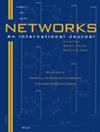Solving vehicle routing problems with intermediate stops using VRPSolver models
IF 1.3
4区 计算机科学
Q4 COMPUTER SCIENCE, HARDWARE & ARCHITECTURE
引用次数: 1
Abstract
In this article, we propose graph‐based models for several vehicle routing problems with intermediate stops: the capacitated multi‐trip vehicle routing problem with time windows, the multi‐depot vehicle routing problem with inter‐depot routes, the arc routing problem with intermediate facilities under capacity and length restrictions and the green vehicle routing problem. In these models, the set of feasible routes is represented by a set of resource constrained paths in one or several graphs. Intermediate stops are supported by the possibility to define negative resource consumption for some arcs. The models that we propose are then solved by VRPSolver, which implements a generic branch‐cut‐and‐price exact algorithm. Thus, a simple parameterization enables us to use several state‐of‐the‐art algorithmic components: automatic stabilization by dual price smoothing, limited‐memory rank‐1 cuts, reduced cost‐based arc elimination, enumeration of elementary routes, and hierarchical strong branching. For each problem, we numerically compare the proposed methodology with the best exact approach found in the literature. State‐of‐the‐art computational results were obtained for all problems except one.利用VRPSolver模型求解中间站点车辆路径问题
在本文中,我们提出了几个具有中间站点的车辆路径问题的基于图的模型:具有时间窗口的容量多行程车辆路径问题、具有车间间路径的多站点车辆路径问题,具有容量和长度限制的中间设施的弧形路径问题以及绿色车辆路径问题。在这些模型中,可行路径集由一个或多个图中的一组资源约束路径表示。为某些圆弧定义负资源消耗的可能性支持中间停止。然后,我们提出的模型由VRPSolver求解,该算法实现了一种通用的分支切割和价格精确算法。因此,一个简单的参数化使我们能够使用几个最先进的算法组件:通过双重价格平滑的自动稳定、有限的内存秩1切割、降低成本的消弧、基本路径的枚举和分层强分支。对于每个问题,我们将所提出的方法与文献中发现的最佳精确方法进行了数值比较。除一个问题外,所有问题都获得了最先进的计算结果。
本文章由计算机程序翻译,如有差异,请以英文原文为准。
求助全文
约1分钟内获得全文
求助全文
来源期刊

Networks
工程技术-计算机:硬件
CiteScore
4.40
自引率
9.50%
发文量
46
审稿时长
12 months
期刊介绍:
Network problems are pervasive in our modern technological society, as witnessed by our reliance on physical networks that provide power, communication, and transportation. As well, a number of processes can be modeled using logical networks, as in the scheduling of interdependent tasks, the dating of archaeological artifacts, or the compilation of subroutines comprising a large computer program. Networks provide a common framework for posing and studying problems that often have wider applicability than their originating context.
The goal of this journal is to provide a central forum for the distribution of timely information about network problems, their design and mathematical analysis, as well as efficient algorithms for carrying out optimization on networks. The nonstandard modeling of diverse processes using networks and network concepts is also of interest. Consequently, the disciplines that are useful in studying networks are varied, including applied mathematics, operations research, computer science, discrete mathematics, and economics.
Networks publishes material on the analytic modeling of problems using networks, the mathematical analysis of network problems, the design of computationally efficient network algorithms, and innovative case studies of successful network applications. We do not typically publish works that fall in the realm of pure graph theory (without significant algorithmic and modeling contributions) or papers that deal with engineering aspects of network design. Since the audience for this journal is then necessarily broad, articles that impact multiple application areas or that creatively use new or existing methodologies are especially appropriate. We seek to publish original, well-written research papers that make a substantive contribution to the knowledge base. In addition, tutorial and survey articles are welcomed. All manuscripts are carefully refereed.
 求助内容:
求助内容: 应助结果提醒方式:
应助结果提醒方式:


